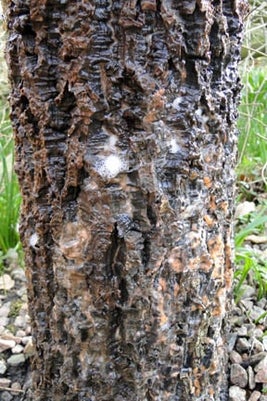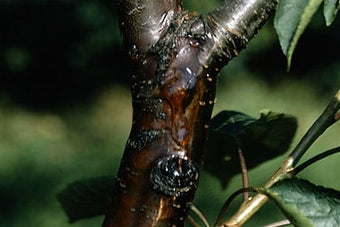
Quick facts
Common name - Bacterial slime flux
Scientific name - Various species of bacteria
Plants affected - Cordyline
Main symptoms - A foul-smelling, slimy ooze
Caused by - Bacteria
What is the problem?
There are two problems that are connected. The first is frost damage. This causes ice crystals to form in the water-conducting vessels in the stem and roots (where exposed to cold), leading to tissue damage. These wounds then provide entry points for the second problem: bacterial slime flux. The bacteria doesn't actively 'attack' the cordyline but will enter through this damaged tissue.
Slime flux is not usually fatal. The bacteria are found mainly in the damaged and rotting tissue. However, as it appears in damaged tissue (caused by frost), it is likely that this area of stem is dead/rotting/dying anyway; and so will need to be removed.
Symptoms
Indicators of frost damage
- The crown of leaves initially appear to 'wilt' or flop. The leaves often fall away individually, collecting on the ground in noticeable amounts
- The growing point in the centre of the foliage is brown, soft and rotting
- Rotting may also appear on the stem where frost has penetrated
- Young cordyline plants are most likely to be damaged by frost; but can even kill mature specimens
Indicators of bacterial slime flux
- Patches on the stem ooze white (sometimes frothy) or orange-tinged liquid
- The ooze has a foul smell
- There may be black staining below the patch of ooze
Control
There are no preventative or control measures, unfortunately, as the main cause of these problems was the intense cold in December 2010. However, here are some steps you can take to deal with this issue if it occurs after other severe winters.
- The bacterial ooze can be scrubbed off to reduce the offensiveness of its appearance and smell. However, the ooze can not be plugged or stopped; and there is no cure
- Cordylines affected by frost can be pruned back to living tissue with a saw or secateurs. If this is part way up the main trunk, it is possible that it will sprout just below the cut to form a new head of foliage in summer. Where the main trunk is badly damaged by frost (seen by discolouration and softening of the tissue), the whole stem is dead and will need to be cut off at ground level – in this case, it is still possible for shoots to appear from ground level in June-September
- Any new shoots that appear the following summer should, ideally, be protected in the following winter. Fold up the leaves like an umbrella and cover with a double layer of fleece. These measures will provide several degrees of additional frost protection, but are no defence against really cold winters. The only sure way to keep cordylines from year-to-year is by overwintering in a frost-free greenhouse
- December 2010 was the coldest the UK has experienced since national records began in 1910. While climate change predicts warmer, wetter winters; the overriding factor is the weather will become more unpredictable – so extremes in temperature can still be expected. This means that gardeners will need to be more adaptable, replacing plants or choosing tougher ones where maintenance needs to be reduced
Biology
Cordyline slime flux develops when a damaged part of the stem becomes colonised by bacteria that normally reside harmlessly in the soil or on the stem surface. Any factor that injures the stem can lead to the problem developing, however, the 2011 problems were connected to frost damageto the and roots.
The bacteria penetrate deep into the stem tissues, and when the sugary rises in spring this is fermented by the bacteria to produce the foul-smelling slime. Gasses are also produced which force the slime out under pressure and may result in further stem splitting. A range of bacterial species, as well as other organisms such as yeasts and fungi, are often found within the slime, all taking advantage of the sugars within the sap.
Other trees, shrubs and climbers
Slime flux and a similar disease called bacterial wetwood are also found quite frequently on the stems of a wide range of trees and shrubs. The biology is similar to that of clematis slime flux, although it is thought that in trees the bacteria most usually colonise the plant through the roots. Weeping and fluxing from patches on the trunk is often the only symptom, but branch dieback may occur. Clematis slime flux is perhaps the most common and is seen in spring.




